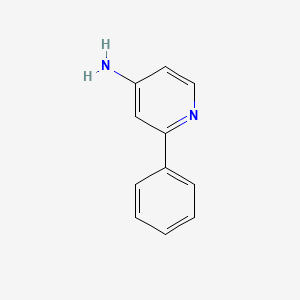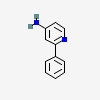2-Phenylpyridin-4-amine
- 2-phenylpyridin-4-amine
- 21203-86-1
- 4-Amino-2-phenylpyridine
- 2-PHENYL-PYRIDIN-4-YLAMINE
- MFCD01646280
- Create:2005-07-19
- Modify:2024-12-28

- 2-phenylpyridin-4-amine
- 21203-86-1
- 4-Amino-2-phenylpyridine
- 2-PHENYL-PYRIDIN-4-YLAMINE
- MFCD01646280
- CHEMBL1770738
- 4-Pyridinamine,2-phenyl-
- 2-PHENYL-4-PYRIDINAMINE
- A1AB0
- SCHEMBL3788626
- DTXSID00376494
- CHVKPWIABFICLK-UHFFFAOYSA-N
- CS-D1566
- BDBM50342659
- AKOS006283666
- AB09616
- FS-3258
- 2-phenyl-pyridin-4-ylamine, AldrichCPR
- SY032946
- DB-081294
- EN300-74480
- AC-907/34122018
- J-514340
- F2167-2399
- Z1083217772


H302 (100%): Harmful if swallowed [Warning Acute toxicity, oral]
H312 (100%): Harmful in contact with skin [Warning Acute toxicity, dermal]
H315 (100%): Causes skin irritation [Warning Skin corrosion/irritation]
H318 (100%): Causes serious eye damage [Danger Serious eye damage/eye irritation]
H332 (100%): Harmful if inhaled [Warning Acute toxicity, inhalation]
H335 (100%): May cause respiratory irritation [Warning Specific target organ toxicity, single exposure; Respiratory tract irritation]
P261, P264, P264+P265, P270, P271, P280, P301+P317, P302+P352, P304+P340, P305+P354+P338, P317, P319, P321, P330, P332+P317, P362+P364, P403+P233, P405, and P501
(The corresponding statement to each P-code can be found at the GHS Classification page.)
Acute Tox. 4 (100%)
Acute Tox. 4 (100%)
Skin Irrit. 2 (100%)
Eye Dam. 1 (100%)
Acute Tox. 4 (100%)
STOT SE 3 (100%)
Patents are available for this chemical structure:
https://patentscope.wipo.int/search/en/result.jsf?inchikey=CHVKPWIABFICLK-UHFFFAOYSA-N
- CAS Common ChemistryLICENSEThe data from CAS Common Chemistry is provided under a CC-BY-NC 4.0 license, unless otherwise stated.https://creativecommons.org/licenses/by-nc/4.0/2-Phenyl-4-pyridinaminehttps://commonchemistry.cas.org/detail?cas_rn=21203-86-1
- EPA DSSTox2-phenylpyridin-4-aminehttps://comptox.epa.gov/dashboard/DTXSID00376494CompTox Chemicals Dashboard Chemical Listshttps://comptox.epa.gov/dashboard/chemical-lists/
- European Chemicals Agency (ECHA)LICENSEUse of the information, documents and data from the ECHA website is subject to the terms and conditions of this Legal Notice, and subject to other binding limitations provided for under applicable law, the information, documents and data made available on the ECHA website may be reproduced, distributed and/or used, totally or in part, for non-commercial purposes provided that ECHA is acknowledged as the source: "Source: European Chemicals Agency, http://echa.europa.eu/". Such acknowledgement must be included in each copy of the material. ECHA permits and encourages organisations and individuals to create links to the ECHA website under the following cumulative conditions: Links can only be made to webpages that provide a link to the Legal Notice page.https://echa.europa.eu/web/guest/legal-notice2-phenylpyridin-4-aminehttps://echa.europa.eu2-phenylpyridin-4-amine (EC: 997-943-1)https://echa.europa.eu/information-on-chemicals/cl-inventory-database/-/discli/details/385076
- ChEMBLLICENSEAccess to the web interface of ChEMBL is made under the EBI's Terms of Use (http://www.ebi.ac.uk/Information/termsofuse.html). The ChEMBL data is made available on a Creative Commons Attribution-Share Alike 3.0 Unported License (http://creativecommons.org/licenses/by-sa/3.0/).http://www.ebi.ac.uk/Information/termsofuse.htmlChEMBL Protein Target Treehttps://www.ebi.ac.uk/chembl/g/#browse/targets
- Japan Chemical Substance Dictionary (Nikkaji)
- Nature Chemistry
- PharosLICENSEData accessed from Pharos and TCRD is publicly available from the primary sources listed above. Please respect their individual licenses regarding proper use and redistribution.https://pharos.nih.gov/about2-phenylpyridin-4-aminehttps://pharos.nih.gov/ligands/MADPJX2WVK6D
- RCSB Protein Data Bank (RCSB PDB)LICENSEData files contained in the PDB archive (ftp://ftp.wwpdb.org) are free of all copyright restrictions and made fully and freely available for both non-commercial and commercial use. Users of the data should attribute the original authors of that structural data.https://www.rcsb.org/pages/policies
- Springer Nature
- Wikidata2-phenylpyridin-4-aminehttps://www.wikidata.org/wiki/Q82165409
- PubChem
- MolGenieMolGenie Organic Chemistry Ontologyhttps://github.com/MolGenie/ontology/
- PATENTSCOPE (WIPO)SID 390439936https://pubchem.ncbi.nlm.nih.gov/substance/390439936

